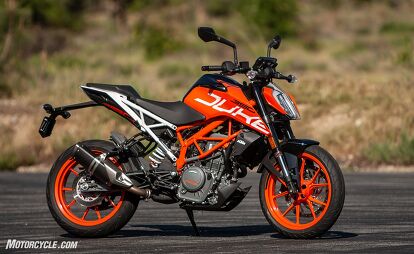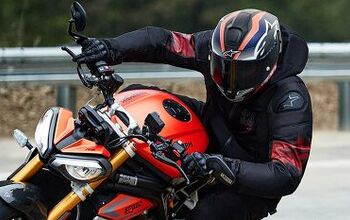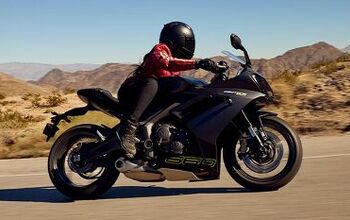Lightweight Rippers: 2019 KTM 390 Duke Vs. 2019 Kawasaki Z400

Can the Z400 dethrone one of the best lightweight nakeds ever built?
KTM has changed the way we look at small-displacement naked bikes with the 390 Duke. No longer is it just a learning tool for new or inexperienced riders, but now, no matter who you are, if you can’t find a way to have an ear-to-ear grin riding the baby Duke, you probably don’t have a pulse. If it’s not clear by now, we love the 390 Duke around here – its 373cc Single is anything but boring, it handles surprisingly well, and its looks are sharp enough to convince you to park it where everyone can see.
Fortunately, KTM aren’t the only ones playing in the small-displacement, naked bike field. BMW also has a contender with the G310R, but when we put it up against the KTM it simply fell short. For starters, its 313cc Single just couldn’t keep up, its smaller engine producing 31.5 horses compared to the Duke’s 39.1 hp. Its 19.3 lb-ft also couldn’t compete with the Duke’s 23.6 lb-ft. We found the BMW a little more comfortable commuting and while doing more mundane things, but once the roads got fun, the KTM displayed its dominance.
A Rival From Japan
Enter now the Kawasaki Z400. Making its debut earlier this year, Johnny-Boy Burns got to shake one out for a First Ride Review, where he liked it a lot – but didn’t love it. The engine makes enough grunt to challenge the KTM, and it both handles and stops well enough. Plus it’s cheap, coming in at $4,799 with ABS. Not exactly a glowing review, but not a bad one either.
Rewind, then, to MO’s Lightweight Sportbike Shootout pitting the KTM RC390 versus the Kawasaki Ninja 400. The Honda CBR500R was there too, but really, it couldn’t hold much of a candle to the other two. Back then, I gave the narrowest of victories to the Kawasaki, while Mr. Burns picked the KTM. We thought surely a future battle between naked versions of the Kawi and Katoom (sorry Honda) would produce equally close results.
And here we are.
One thing to keep in mind, however, is that KTM updated the 390 Duke in 2017, refreshing it with things like edgier styling, TFT display, tweaked ergonomics, better suspension, bigger brakes, and revised exhaust for a smidge more power. For whatever reason, Team Orange decided to leave most of those upgrades off the RC390. Meanwhile, the Z400 is basically a Ninja 400 – a machine I really like – that trades some bodywork for a handlebar. A recipe for success, as far as a street bike is concerned.
An Interesting Matchup
On paper, the two are a close match. The Duke tips the scales at 362 lbs., full of fuel, while the Z is only two pounds more at 364 lbs. Sitting 30.9 inches off the ground, the Z400 has the lower seat height, but because it’s so narrow, the KTM’s 32.7-inch seat doesn’t seem so bad. Geometry numbers are similar too: Rake/Trail/Wheelbase figures measuring 25.0°/3.7 in./53.4 in. for the KTM, while the Kawi comes in at 24.5°/3.7 in./53.9 in. The Z carries a slight fuel capacity advantage with its 3.7-gallon tank (which likely accounts for the two extra pounds on the scale), but the 390 isn’t far behind at 3.5 gallons.
Where the KTM seems to gain an edge is with performance components; befitting its Ready to Race mantra. Its 43mm inverted WP fork is more stout than the Kawi’s 41mm standard Showa unit, though both only have a preload-adjustable shock. When it comes to braking, the KTM brings the heat yet again – its four-piston, radially mounted ByBre caliper bites a single 320mm disc, while the Z400’s 310mm petal-type disc is mated to a Nissin two-pot caliper, which will begin to fade sooner on banzai downhill runs. Both get ABS, but the Duke allows you to turn it off in the rear (aka Supermoto mode), meaning rear wheel slides are a thing!
But of course, the most important measure of performance comes in the engine bay, where the smaller, single cylinder would appear to be the underdog compared to the Kawi’s 399cc engine featuring twice the cylinders, but on the dyno it would be a stretch to say the KTM’s on the back foot.
In fact, the dyno chart reveals the two are incredibly close in performance despite the vastly different engine configurations. The surprise isn’t so much the Kawasaki on top in the horsepower battle – it’s the fact it’s only by a single horse to the smaller KTM! The Duke’s torque advantage also isn’t much of a surprise, as Singles are inherent torque machines. Look at the chart a little closer and you’ll see the Duke has a healthy advantage in the midrange, too. If it’s a close fight you want, these two definitely deliver.
Specs vs. Reality
As we all know, if comparing stats on paper was all it took to determine a winner, then we’d be out of a job. Actually riding the motorcycles is what’s important here. And since both bikes will spend the majority of their time dashing around town and commuting let’s start there. From the saddle, both bikes feel really narrow, though the Kawi’s lower seat height should make shorter riders more confident – not that the Duke is intimidating.
As city runabouts, both prove to be up to the task. Both are narrow enough to easily split through traffic (if you’re allowed to do so where you live) and have enough grunt to never make you bored. Between the two, the KTM lets you be a little lazier with your shifts if you simply want to twist and go, but the reality is, you’ll be shifting a lot with either bike. Thankfully, shifts are nice and crisp on both, and both are equipped with gear position indicators. So. you always know where you are. Both have slip-assist clutches, too, so even if you do botch a downshift (or three), the consequences will be minimal.
Despite the lack of any real wind protection, both the 390 Duke and Z400 are not overly punishing on the highway. Cruising along at 80-90 mph isn’t a problem for either bike, though winding both throttles to the stop showcases how differently each makes its power. You can feel the surge through the midrange on the KTM, while the Kawi comes alive once the tach needle is pointed straight up. Neither feels slow, despite what some might say about this small displacement category.
As far as wind blast is concerned, the KTM has me seated in just a way that I’m not left feeling like a sail at speed. I can’t say the same about the Z400, but the seat slopes at just the right angle to nudge you towards the tank, making the wind slightly easier to manage. Neither seat is especially comfortable for long-distance travel, but we can only hope you’re not looking at either for touring purposes. That said, the KTM does offer a little more space for taller riders to move about the cockpit.
What’s especially surprising is the lack of vibration from either motorcycle, especially at high rpm. Counterbalancers are a wonderful thing, and both Kawasaki and KTM deserve kudos, the latter especially so, as single cylinder engines were once notoriously buzzy. The 390 breaks that mold. Or maybe the 690 Duke did, and the 390 follows right in its tracks.
The X Factor
So far, both bikes have proven to be incredibly evenly matched. The difference maker comes once you veer off the beaten path and head towards the hills. Once the roads get tight and twisty, the KTM shows its true colors. The 320mm front disc and four-pot ByBre caliper slow the 390 down with confidence, no doubt aided by the steel-braided line, and you feel supremely confident leveraging the handlebar to throw the 360-something-pound Duke into bends.
It’s not like the Z400 requires any more effort to toss around, but its conventional fork, smaller brakes, and rubber lines don’t quite inspire the same kind of thrill as the KTM does. If you choose the right gear going into the turn, the Duke’s torque will pull you out cleanly, with a gentle tug that’ll even satisfy an experienced rider. If you’re feeling especially racy, engage Supermoto mode from the ABS setting and get your slide on. It’s next to impossible not to try it without giggling.
And that’s really where the difference is – the KTM is more engaging to ride, more satisfying to toss around, and delivers more character to the rider. All the while, it can perform more mundane tasks like commuting and around-town blasts with ease. The TFT display is bright and easy to read, and makes the LCD screen on the Kawi look ancient. Even the rider triangle on the Duke is slightly more relaxed (albeit by the tiniest of margins), as the Z’s pegs feel slightly higher.
Maybe this seems a little unfair to the Kawasaki. To the Z’s credit, if the 390 Duke didn’t exist, the little Z would be tops in the small displacement naked bike category. Making 44 horses to the wheel is plenty entertaining, the low seat height makes it very inviting, and the $4,799 price tag is definitely more attractive than the KTM’s $5,499 sticker price. It can do nearly everything the Duke can, just with a little less excitement. But if I channel my inner Marie Kondo, it doesn’t spark the same joy as the KTM. If that doesn’t matter as much to you – or you live nowhere close to a KTM dealership – you won’t be disappointed with the Z400. Personally, I’d rather save a few more paychecks and opt for the Orange one.
2019 KTM 390 Duke vs. 2019 Kawasaki Z400 Scorecard | ||
|---|---|---|
Kawasaki Z400 | KTM 390 Duke | |
Price | 100% | 91.7% |
Weight | 99.5% | 100% |
lb/hp | 100% | 97.7% |
lb/lb-ft | 92.5% | 100% |
Total Objective Scores | 98.6% | 96.5% |
Engine | 82.5% | 90.0% |
Transmission/Clutch | 80.0% | 82.5% |
Handling | 82.5% | 90.0% |
Brakes | 75.0% | 85.0% |
Suspension | 80.0% | 86.3% |
Technologies | 77.5% | 85.0% |
Instruments | 72.5% | 87.5% |
Ergonomics/Comfort | 77.5% | 85.0% |
82.5% | 82.5% | |
Cool Factor | 77.5% | 90.0% |
Grin Factor | 77.5% | 87.5% |
Troy’s Subjective Scores | 75.0% | 85.0% |
John’s Subjective Scores | 82.9% | 88.5% |
Overall Score | 82.9% | 88.7% |
| Specifications | 2019 Kawasaki Z400 | 2019 KTM 390 Duke |
|---|---|---|
| MSRP | $4,799 | $5,499 |
| Engine Type | 399cc liquid-cooled DOHC parallel Twin, four valves per cylinder | 373.2cc liquid-cooled DOHC single-cylinder, 4-stroke |
| Bore and Stroke | 70.0 x 51.8mm | 89.0 x 60.0mm |
| Compression Ratio | 11.5:1 | 12.6:1 |
| Horsepower | 43.4 hp at 9700 rpm | 42.3 hp at 8800 rpm |
| Torque | 24.9 lb-ft at 8200 rpm | 26.9 lb-ft at 6900 rpm |
| lb/hp | 8.4 | 8.6 |
| lb/lb-ft | 14.6 | 13.5 |
| Transmission | 6-speed, slip/assist clutch | 6-speed, slip/assist clutch |
| Final Drive | Chain | Chain |
| Front Suspension | 41mm Showa fork, 4.7 inches travel | 43mm WP inverted-fork, 5.6 inches travel |
| Rear Suspension | Uni-Trak single shock; adjustable for spring preload, 5.1 in. travel | WP shock absorber, 5.9 inches travel |
| Front Brake | 310 mm petal disc with Nissin 2-piston caliper; ABS | 320 mm disc with four piston, radially mounted caliper; ABS |
| Rear Brake | 220mm petal disc, 2-piston caliper; ABS | 230mm petal disc, single-piston caliper; ABS |
| Front Tire | 110/70-17 | 110/70 ZR 17 |
| Rear Tire | 150/60-17 | 150/60 ZR 17 |
| Rake/Trail | 24.5°/3.7 inches | 25°/3.7 inches |
| Wheelbase | 53.9 inches | 53.4 ± 0.6 inches |
| Seat Height | 30.9 inches | 32.7 inches |
| Curb Weight | 364 pounds (measured) | 362 pounds (measured) |
| Fuel Capacity | 3.7 gallons | 3.5 gallons |
| Colors | green/black, red/black | orange/white, white/orange |

Troy's been riding motorcycles and writing about them since 2006, getting his start at Rider Magazine. From there, he moved to Sport Rider Magazine before finally landing at Motorcycle.com in 2011. A lifelong gearhead who didn't fully immerse himself in motorcycles until his teenage years, Troy's interests have always been in technology, performance, and going fast. Naturally, racing was the perfect avenue to combine all three. Troy has been racing nearly as long as he's been riding and has competed at the AMA national level. He's also won multiple club races throughout the country, culminating in a Utah Sport Bike Association championship in 2011. He has been invited as a guest instructor for the Yamaha Champions Riding School, and when he's not out riding, he's either wrenching on bikes or watching MotoGP.
More by Troy Siahaan












































































Comments
Join the conversation
Which bike exhibits better bump compliance in stock trim?
Here in South Carolina, with our chronically unfunded infrastructure, potholes are proliferating faster than CBD shops, so that's always one of my first questions.
One thing they don't mention, is that the Kawasaki is more reliable.
I've read of so many issues with the KTM, especially concerning wear after 4k miles, suspension, tire, etc.. Kawasaki is basically near to Honda quality.